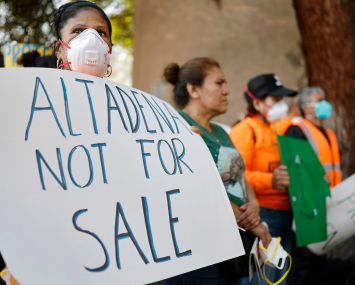NYC Landlords Caught a Break on Local Law 97. Why Is Nobody Happy?
The city’s carbon footprint won’t shrink as fast as advocates would like after the DOB's latest tweak to the landmark climate legislation
By Aaron Short October 4, 2023 11:00 am
reprints
New York City’s most wasteful high-rises won’t have to sweat paying hefty fines next year thanks to what is effectively a last-minute rule change to a landmark climate law.
Still, many landlords aren’t satisfied by the lucky break. Many environmentalists aren’t, either.
The city Department of Buildings (DOB) announced in early September it will allow a two-year grace period for towers to demonstrate they are on track to meet the city’s new carbon emissions standard set by Local Law 97, part of climate legislation the City Council passed in 2019.
“We believe that the decarbonization plan will be an attractive option for buildings that have done little or nothing so far to comply with the law, and are significantly over their carbon emissions limit, as it gives them additional time to start these retrofit projects,” Andrew Rudansky, a spokesperson for the Buildings Department, said in an email to Commercial Observer.
The city’s move came after condo and co-op associations complained for months during several DOB-led working group meetings that they could not line up the financing to replace boilers, swap out windows or make other upgrades to lower greenhouse gas output by the department’s January 2024 deadline.
“As the process wore on, it became clear the problems were not the high-density office towers but the thousands of middle-income co-ops and condos in the boroughs,” one source familiar with the city’s rule-making said. “There was just no way for them to comply with the program.”
Some environmental groups believe the rule change will provide a pathway that will allow inefficient buildings to get into compliance with city law eventually, as opposed to fining the owners.
“I wish every building would comply next year, but the fact of the matter is they won’t and there’s nothing we can do,” said John Mandyck, CEO of the Urban Green Council, a New York City nonprofit. “This is a choice: Do we give up on these buildings and fine them because they’re out of compliance? Or do we find a way to get them under the compliance path so we get them under the compliance savings?”
Others warned that the delay would hinder efforts to reduce real estate owners’ reliance on fossil fuels to power their buildings and help the city meet its long-term climate goals.
“We don’t have two years,” Pete Sikora, climate and inequality campaigns director at New York Communities for Change, a civic group, said. “Society has wasted decades on reducing pollution, so it’s now to avoid global catastrophe that has to drop fast.”
Owners get action
City lawmakers have long sought to compel real estate owners to make their properties more energy efficient, because buildings account for roughly two-thirds of the city’s overall carbon footprint.
The result was the passage of Local Law 97, which requires buildings over 25,000 square feet to reduce their emissions 40 percent by the end of the decade and then by 80 percent by 2050, putting those standards in line with the 2015 Paris Climate Agreement. The law would apply to roughly 50,000 buildings, covering nearly 60 percent of New York City’s total building area of 3.15 billion square feet. At the same time, the city would work with Con Edison to electrify its grid by bringing two transmission lines transporting hydropower from Canada.
The city initially projected that 80 percent of those buildings would be under the emissions limit for the first benchmark by 2024. Instead, 89 percent of properties met the city’s energy goals this year, DOB officials said. That left about 1,500 buildings, some of which were among the city’s largest skyscrapers, with substantial work to do in order to comply with the law.
Daniel Zarrilli, the former chief climate policy adviser under Mayor Bill de Blasio who helped craft Local Law 97, believes the legislation is working as intended.
“Knowing that the city enforces the law, people are now absorbing the reality of this and doing what they can to comply,” Zarrilli said. “What’s most important to me is that the 2030 goals are not up for debate — everyone has enough time to plan and do the work to meet them.”
But the COVID-19 pandemic prevented the city from rolling out its carbon regulations in a timely fashion. The process still isn’t finished with four months left in the year, prompting many real estate owners to ask for an extension.
Instead of penalizing buildings out of compliance, the DOB is proposing a reprieve, as long as owners enter into an agreement with the city that they will upgrade their lighting, conduct an energy audit, hire professionals, and submit benchmark reports as well as a roadmap detailing how they will reduce their long-term emissions. Owners would still have to meet the 2024 emissions targets by 2026 and show progress that they would reach the city’s 2030 goals without purchasing renewable energy credits to avoid doing any expensive retrofits in the future.
“The 2030 limit is much more stringent than the 2024 limit, which is why we are pushing these worst-performing buildings to meet that much more significant milestone on time through the Decarbonization Plan route,” the DOB spokesman said.
A spokesperson for industry lobbyist, the Real Estate Board of New York, which has warned about the collective cost of fines for its members and pushed for changes, said the association was still reviewing the city’s proposal.
Some of New York’s most influential commercial real estate owners still weren’t satisfied and claimed that the city wouldn’t achieve its goals because its electric grid hasn’t been upgraded to handle more renewable power.
“The rules still do not account for high-density, high-performance spaces, and contradict the health and wellness aspects of large buildings that require more energy,” Durst Organization Chairman Douglas Durst said in a statement. (Durst buildings such as One Bryant Park — a LEED Platinum tower per the U.S. Green Building Council — had before Local Law 97 been celebrated for their environmentally friendly operations, but are now likely to overshoot their carbon limits under the law.) “By prematurely forcing buildings to electrify, carbon emissions will actually increase because the grid has yet to add any significant renewable energy sources.”
Environmentalists’ next move
Reaching the city’s goals without the city’s two-year extension could be complicated, but advocates have a few options.
The Department of Buildings is expected to finalize its rules after the public comment period on them expires Oct. 24. Some environmentalist groups are focusing on pressuring the mayor to change his position on the delays and urge the City Council to override him and amend the law if he won’t.
Getting the City Council on the same page will be a challenge. Members of its Progressive Caucus have questioned why the city needed a two-year delay to enforce the law.
“I am concerned decarbonization plans are soft and provide an out for buildings to delay action for two more years,” said Lincoln Restler, a City Council member from Brooklyn. “We need to send a strong and unified message that there are no loopholes and no viable outcomes other than significantly reducing their carbon footprint.”
But the council’s environmental chair, James Gennaro, applauded Mayor Adams and the Department of Buildings for finding alternative pathways of compliance. And council member Vickie Paladino of Queens introduced a bill in February that would delay Local Law 97’s implementation for seven years. It already has a dozen sponsors.
Progressives are also running out of time to act on the city’s proposed decarbonization plan and may struggle to galvanize a majority on a contentious issue that has divided members.
“People really want the law to take effect and they want two years to see how it’s working,” Pat McClellan, policy director of the New York League of Conservation Voters, said. “This was a politically fraught law as it was being debated and, as it’s moving through implementation, it’s becoming an even more hot button issue.”
Instead, council members may target renewable energy credits (RECs), which would allow real estate owners to purchase offsets in lieu of making more substantial investments in their buildings. Those credits don’t exist yet, giving lawmakers time to adjust the rules.
In the meantime, building owners are looking for the federal government and the state to help with upgrades. Jay Martin, executive director of the Community Housing Improvement Program, which represents owners of rent-stabilized buildings, projected it would cost landlords an average of $2 million to meet the city’s compliance standards.
“We think the federal government is going to have to step in with subsidies or some kind of tax offset,” he said. “Banks so far have been unwilling to lend on these improvements because they don’t see any way to raise revenue on the buildings.”
As severe flooding brought the city to a standstill on Sept. 29, Sikora contended that the city needs to take this crisis seriously and that further delays in implementation amount to “climate denial.”
“The law should not be weakened. We need good jobs to solve the climate crisis, not rising sea levels,” Sikora said on Sept. 29. “What we saw today was a taste of an uncontrolled, terrifying future and that’s an existential threat to the city.”


